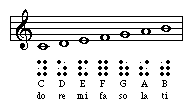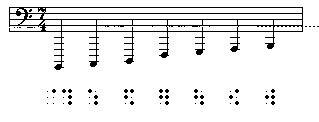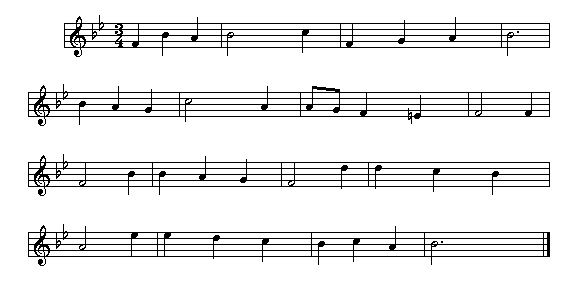|
There are seven notes in a musical scale, typically beginning with the note "C", followed by: D E F G A B. These notes are also sometimes designated "do re mi la so la ti", but you will probably not encounter that notation. The braille equivalents of the seven basic notes must be memorized, using these guidelines to help:
- Eighth notes have no dots 3 or 6
- Quarter notes have a dot 6
- Half notes have a dot 3 but no dot 6
- Whole notes have both dots 3 and 6
For example, the scales for quarter notes and whole notes are shown below, followed by a table of all of the notes:


[Note: the example above is slightly incorrect, in that octave marks are needed, but are not used as they have not been presented to the student yet!]
| Type |
C |
D |
E |
F |
G |
A |
B |
Rest |
| Wholes or 16ths |
 |
 |
 |
 |
 |
 |
 |
 |
| Halves or 32nds |
 |
 |
 |
 |
 |
 |
 |
 |
| Quarters or 64ths |
 |
 |
 |
 |
 |
 |
 |
 |
| 8ths or 128ths |
 |
 |
 |
 |
 |
 |
 |
 |
Some notes are also "dotted", meaning they have a extra time value. The dotted braille notation is a dot 3  . .
A simple example should help:


For smaller notes and rests, such as 128ths, the braillist should use this chart. Basically, you use the same symbols as for eighth, quarter, half, and whole notes:
| Regular value |
Smaller value |
Braille |
| Eighth note (1/8) |
128th note |
 |
| Quarter note (1/4) |
64th note |
 |
| Half note (1/2) |
32nd note |
 |
| Whole note |
16th note |
 |
Octave Marks
Now comes the really tricky part of writing notes! Notes come in octaves, units of seven notes. You can have the same note name but in several different octaves. For example, the note "C" can be found in many different octaves. We need some way in braille to represent the same note as seen in the various octaves. Octave marks serve that purpose.
Octave Marks:
| 1st (bass) |
 |
 |
2nd (bass) |
 |
 |
3rd (bass) |
 |
 |
4th (treble) |
 |
 |
5th (treble) |
 |
 |
6th (treble) |
 |
 |
7th |
 |
 |
There are, as you might suspect, a list of rules for the use of octave marks:
- an octave mark is always required before the first note in a line of music
- when the interval between two notes is a second or a third, no octave mark is required. To figure out an interval, count the spaces and lines between two notes, making sure to include the notes themselves. For example:
| Interval name |
Interval |
Description |
| Second |
 |
Starting on middle C, the interval goes up one whole step to a D. Counting both the C and the D, the interval is a second |
| Third |
 |
Starting on middle C, count the C, the space after the C, and the E note on the first line. This interval is a third. |
| Fourth |
 |
Starting on middle C, the interval goes up to an F, the first space on the staff. C-d-e-F gives you an interval of a fourth. The lower case notes in the previous sentence indicate skipped notes. |
| Fifth |
 |
C-d-e-f-G, a fifth |
| Sixth |
 |
C-d-e-f-g-A, a sixth |
- when the interval is a fourth or a fifth, an octave mark is required only when the second note is in a different octave.
- when the interval is a sixth or greater, the octave mark is always used.
An example is certainly useful at this point!


A measure-by-measure analysis:
- This measure starts with an octave 4 mark (dot 5), since it is the first measure
- no octave mark
- this measure starts with an octave 4 mark, since the last note in the previous measure (the C) is a fifth away from the first note in Measure 3 (an F). The "fifth" rule says to use an octave mark when the second note is in a different octave. The C is in the fifth octave, and the F is in the fourth. Why didn't we use the octave 5 marker for the C? Because it only had an interval of a second (B --> C) from the previous note.
- no octave mark here, still in Octave 4
- no octave mark here, still in Octave 4
- this measures starts with an octave 5 mark, since the C is a fourth from the preceding G. We do not need an octave mark before the A, since its interval is a third
- no octave marks here
- no octave marks here
- no octave marks here
- no octave marks here
- Measure 11 uses an octave 5 marker, since the interval from the F to the D is a sixth.
- no octave marks here
- The interval skip of a fifth from the A to the E, spanning Octaves 4 and 5, requires the use of the octave 5 marker.
- no octave marks here
- no octave marks here
- no octave marks here
|